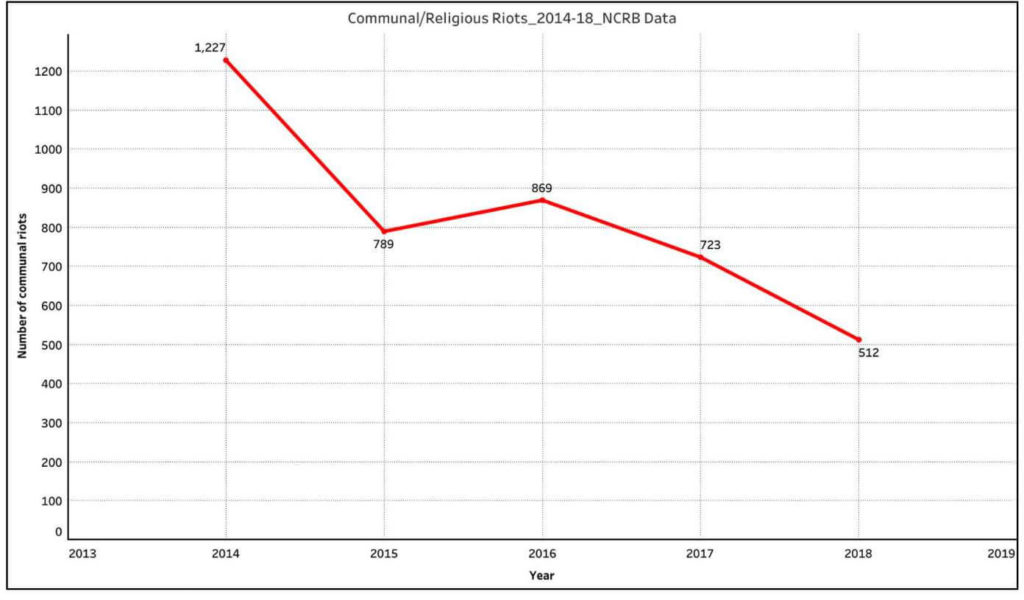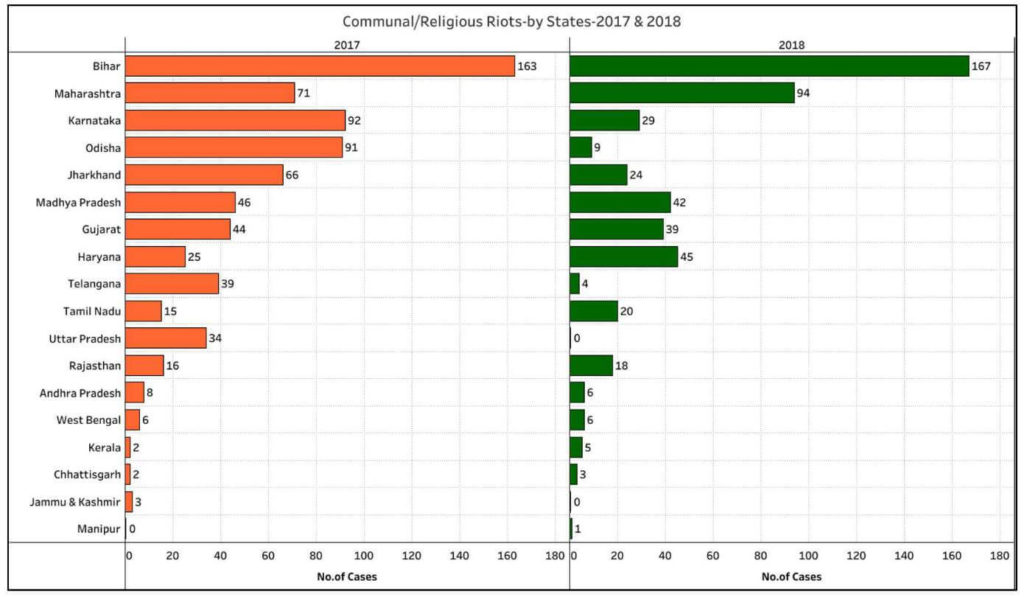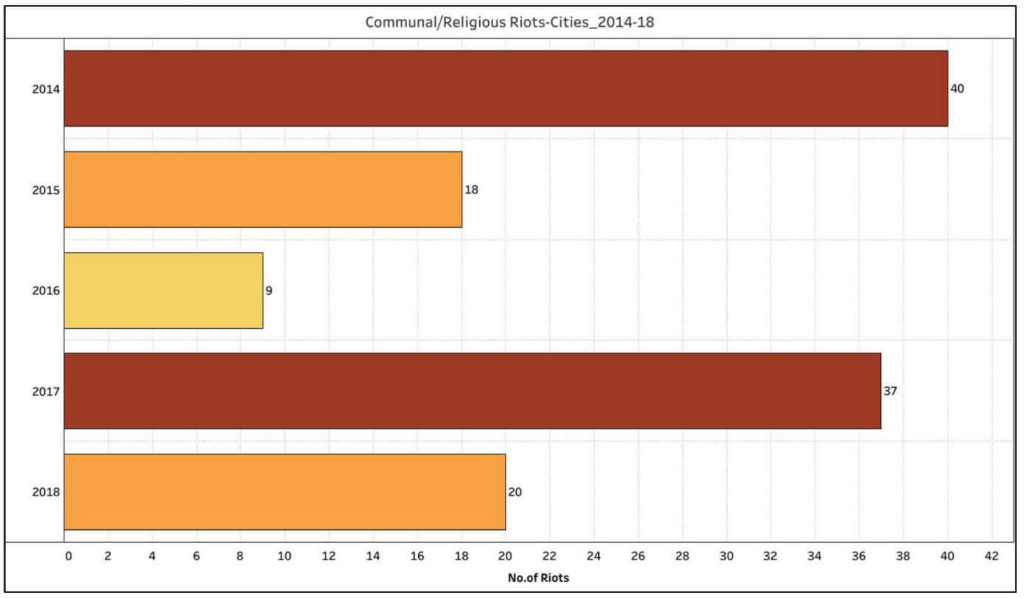Debate on communal riots is a constant in public discourse these days. While NCRB provides data on riots with a ‘communal/religious’ reasons, the Home Ministry which provided data on communal incidents till 2017 has now stopped providing such data.
Over the past few years, communal incidents and riots have been constant in public discourse. Data provided by law enforcement authorities does indicate a substantial number of communal incidents every year across the country.
In an earlier story on Factly, the trends relating to communal riots were analysed until the year 2017. In this story, we look at the incidence of communal riots as per NCRB’s (National Crime Record Bureau) Crime in India (CII) – 2018 report.
Incidence of communal riots have reduced in 2018 as per NCRB report
Starting in 2014, the NCRB has modified its formats and included details on riots due to ‘communal/religious’ reasons to be reported separately.
As per the NCRB’s 2018 CII report, 512 cases of riots that are ‘communal/religious’ in nature have been recorded with the police. This is lower than that of 2017 when 723 such incidents were reported. The 2017 figure is was lower than in the previous years.
Over the five-year period (2014-18) i.e. from the data relating to communal/religious riots is being separately recorded, the number of cases has dropped by more than half. In the year 2014, the incidence of such cases was 1,227 which also happens to be the highest in these five years. However, it also needs to be noted that these are incidents reported by the state police and may not fully represent the actual number of incidents on the ground.

Bihar continues to report the highest number of ‘Communal Riot cases’
In 2017, Bihar recorded the highest number of communal/religious riots with 163 cases. In the year 2018, this number increased marginally to 167 and is still the highest among the States & UTs.
Haryana, which reported a substantial reduction in such incidents in 2017(25) compared to 2016 (250), saw an increase in such cases in 2018 (45 incidents). The number of incidents recorded also increased in the case of Maharashtra from 71 in 2017 to 94 in 2018, which also happens to be the second-highest in the country. It replaces Karnataka at second position, where the number of cases reduced to 29 in 2018.
Telangana which reported an increase in the number of cases in 2017 (39 cases) compared to the zero cases the earlier year, reported only 4 instances of communal riots in 2018. Number of cases in Odisha also witnessed a sharp fall with 9 cases in 2018, compared to that of 91 cases in 2017. Surprisingly, Uttar Pradesh hasn’t reported a single incident related to communal/religious riots for the year 2018.

Fewer number of cases recorded in Cities for the year 2018
Since 2016, the NCRB Report provides data relating to various crimes across 19 cities in India whose population is more than 2 million (i.e. 20 lakhs). Prior to that, the data for a larger group of 53 cities was provided in the NCRB report.
For the year 2018, 20 incidents of communal/religious riots were recorded across the 19 cities. Whereas in the year 2017, 37 such incidents were recorded. During this period (2014 to 2018), the highest number of such incidents was reported in 2014, when 40 such incidents were reported from these 19 cities.
A major portion of the cases recorded in 2018 was in Kanpur with 11 cases. Even in 2017, Kanpur recorded a higher number of cases (11 cases) along with Pune which also reported 11 cases.

Specific reason for a large number of riots is not known
In 2018, there were more than 57 thousand cases of riots across the country as reported by NCRB, of which the 512 cases of Communal/Religious riots constitute less than 1% of the total.
Same was the situation in earlier years, wherein the incidents of Communal/Religious riots formed a minute part of the total cases booked under riots. The other reasons for rioting include – Sectarian, Industrial, Political, Caste Conflict, Family disputes, Rivalry, Water disputes, Land etc. Of these, a major chunk of the cases is recorded under Land Disputes.
In 2018, more than 12 thousand cases of riots are booked under the head ‘Land Disputes’. With the rest of the heads accounting between 1-2% each at best. However, the highest portion of the riot cases is categorized as ‘Other Rioting’ where specific reasons are not known. In 2018 alone, around 24 thousand cases i.e. 42% of the riot cases are reported in this category.
Prior to 2017, more than 90% of the total riot cases were reported in NCRB data as ‘Other Rioting’. The share of this category has now reduced after new categories including ‘land disputes’ were introduced in 2017.
Since a major portion of these incidents is categorized under ‘Other rioting’, specific details about these incidents are not known and it is possible that communal riot incidents may also be included in this category by the state police. Furthermore, there are riots recorded under – ‘sectarian’, ‘Caste conflicts’, ‘Vigilant’ etc. which could also be related to communal/religious riots.
Is the data reliable?
Uttar Pradesh reported ‘zero’ such incidents in 2018. However, the violence that broke out in Kasganj in January 2018 was a result of communal clashes. The UP Police lodged 5 FIRs under various sections of the Indian Penal Code (IPC). FIRs included Section 295 of the IPC which is about ‘injuring or defiling place of worship with intent to insult the religion’.
However, as per the UP DGP, this was not an incident of communal violence, but a group clash and may have been reported as an offence related to religion. UP reported 192 offences relating to religion in 2018.
Such technical categorization of cases without the underlying context defeats the entire purpose of understanding specific types of offences.
Data relating to communal/religious riots not available with MHA for 2018
An earlier story of Factly analysed the variance between the data provided in the NCRB report and the data with the Ministry of Home Affairs (MHA), provided in response to the Lok Sabha questions. The data did not match even for a single year.
Inconsistency in the methodology of collating the data i.e. NCRB numbers being based on the FIRs filed, categorization of the crime, principle offence rule etc. are some of the reasons offered by the government for the difference in the numbers.
The MHA has in response to various questions in parliament has provided information regarding the communal/religious riots till the year 2017. On 11 December 2018, the MHA provided data for 2014 to 2017.
Strangely enough, responding to a question in Lok Sabha on 19 November 2019, the Minister of State for Home Affairs, stated that the responsibility of maintaining the data rests with respective State governments and did not provide any numbers. It is intriguing to note that the MHA which provided this data till 2017 is now saying that the responsibility lies with the state governments.

Although, the respective state governments have the primary responsibility of collecting and maintaining the data since law & order is a state subject, the MHA been collating the information and furnishing the same until 2017 as is evident from the information provided in Lok Sabha. However, for reasons not known, the MHA is not disclosing this data for 2018.
Factly has written to Ministry of Home Affairs seeking clarification on this change and this article will be updated as and when a response is received.


